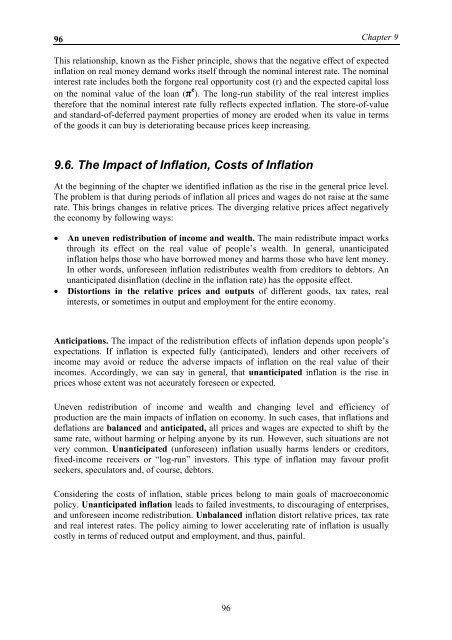MacroeconomicsI_working_version (1)
Create successful ePaper yourself
Turn your PDF publications into a flip-book with our unique Google optimized e-Paper software.
96<br />
Chapter 9<br />
This relationship, known as the Fisher principle, shows that the negative effect of expected<br />
inflation on real money demand works itself through the nominal interest rate. The nominal<br />
interest rate includes both the forgone real opportunity cost (r) and the expected capital loss<br />
on the nominal value of the loan (π e ). The long-run stability of the real interest implies<br />
therefore that the nominal interest rate fully reflects expected inflation. The store-of-value<br />
and standard-of-deferred payment properties of money are eroded when its value in terms<br />
of the goods it can buy is deteriorating because prices keep increasing.<br />
9.6. The Impact of Inflation, Costs of Inflation<br />
At the beginning of the chapter we identified inflation as the rise in the general price level.<br />
The problem is that during periods of inflation all prices and wages do not raise at the same<br />
rate. This brings changes in relative prices. The diverging relative prices affect negatively<br />
the economy by following ways:<br />
• An uneven redistribution of income and wealth. The main redistribute impact works<br />
through its effect on the real value of people’s wealth. In general, unanticipated<br />
inflation helps those who have borrowed money and harms those who have lent money.<br />
In other words, unforeseen inflation redistributes wealth from creditors to debtors. An<br />
unanticipated disinflation (decline in the inflation rate) has the opposite effect.<br />
• Distortions in the relative prices and outputs of different goods, tax rates, real<br />
interests, or sometimes in output and employment for the entire economy.<br />
Anticipations. The impact of the redistribution effects of inflation depends upon people’s<br />
expectations. If inflation is expected fully (anticipated), lenders and other receivers of<br />
income may avoid or reduce the adverse impacts of inflation on the real value of their<br />
incomes. Accordingly, we can say in general, that unanticipated inflation is the rise in<br />
prices whose extent was not accurately foreseen or expected.<br />
Uneven redistribution of income and wealth and changing level and efficiency of<br />
production are the main impacts of inflation on economy. In such cases, that inflations and<br />
deflations are balanced and anticipated, all prices and wages are expected to shift by the<br />
same rate, without harming or helping anyone by its run. However, such situations are not<br />
very common. Unanticipated (unforeseen) inflation usually harms lenders or creditors,<br />
fixed-income receivers or “log-run” investors. This type of inflation may favour profit<br />
seekers, speculators and, of course, debtors.<br />
Considering the costs of inflation, stable prices belong to main goals of macroeconomic<br />
policy. Unanticipated inflation leads to failed investments, to discouraging of enterprises,<br />
and unforeseen income redistribution. Unbalanced inflation distort relative prices, tax rate<br />
and real interest rates. The policy aiming to lower accelerating rate of inflation is usually<br />
costly in terms of reduced output and employment, and thus, painful.<br />
96




